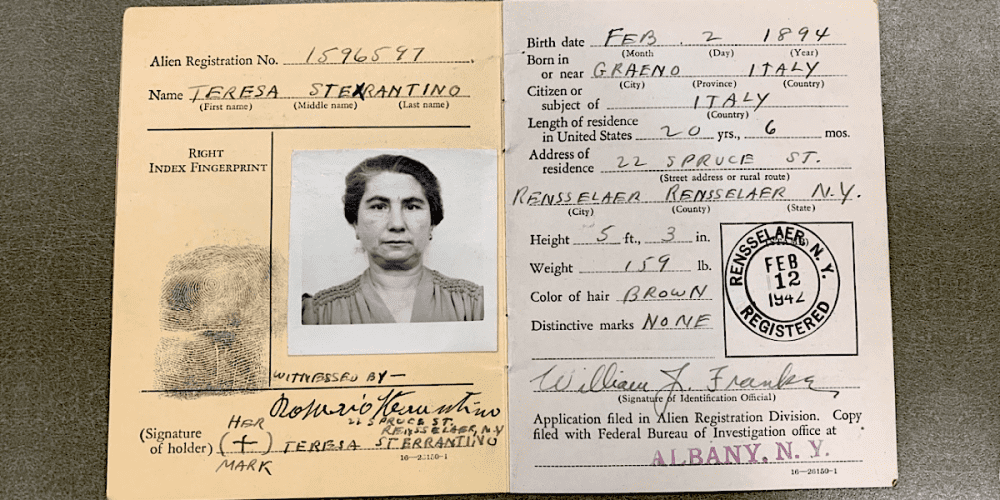Today I visited the National Archives in Kansas City where I viewed the original alien case file documents for my great-great aunt, Teresa Sterrantino nèe Sulfaro.
When it comes to genealogical research only meeting the relative in person comes as close to the excitement of touching their original, signed documents. These beautiful photos and forms were well preserved in an old folder, perhaps not seen by a member of the public since Teresa herself put her pen to them.

First, I should explain what “alien” means in the context of immigration. No, they’re not saying she’s a green, martian from Mars. It simply means that she is not a citizen of the United States. As a permanent resident of the United States I am a “legal alien” because I have been permitted to reside in the country, but I am not a citizen.
*If you’re not interested in the research process scroll down to the section entitled “Alien Case File: Teresa Sulfaro Sterrantino”.
How I Tracked Down The Alien Case File For Teresa Sterrantino
To find these records I first looked through the National Archives catalogue to see what kind of immigration documents they kept from the early 20th century. While the application process for immigration and naturalization was far simpler back then, it was still a process that created a paper trail.
Of all my relatives who moved to the United States between 1900 and 1940 only Teresa Sulfaro (who married Pasquale Sterrantino and thus became Teresa Sterrantino) had alien case file documents kept by the National Archives. This is because she did not start the naturalization process until 1961 and so her records were housed in the Series: Alien Case Files, 1944-2003 repository.
In a case of true serendipity the records were housed by the National Archives office in Kansas City, just a 3.5 hour drive from where I live! As luck would have it I was also planning a trip to KC in less than two weeks.
To request to view Teresa’s file in person, I was required to submit a written request via email at least three business days in advance of my visit along with the time and date I would be visiting. Included in this request was all the details of the case file.
Here’s my email to the archivist in Kansas City:
—
Hello,
I am requesting to view the following alien case file in person at the National Archives in Kansas City on 11/21 at 11am.
Request Information:
Name: Teresa Sterrantino (maiden name Sulfaro)
National Archives Identifier: 5196845
Local Identifier: A1596597/085-07-0633/Box 118
Alien Registration Number: A1596597
Date of Birth: 2/2/1984
Date of Entry into the United States: 7/28/1921
Husband Name: Rosario Sterrantino
Link to Alien Case File on National Archives Catalog: https://catalog.archives.gov/id/5196845
Please let me know if there’s any more information I can provide.
Thank you!
—
The archivist responded very quickly. She asked if I wanted her to double check whether the file I was requesting matched the person I was trying to research. I said, sure, and so she pulled the file and provided me with some details. It was a match! Here was her next email:
—
Dear Josephine:
Great! I have you on our research room calendar.
When you arrive please be sure to have a photo ID available so you can complete our researcher application process. You are welcome to bring a camera and/or flatbed scanner to capture images of the file. We also have a photocopier available ($0.25 per page, payable by credit card or check) if you want to make copies.
Please let me know if you have any questions in the interim.
—
The Kansas City National Archives Reading Room
We woke up early and drove from Northwest Arkansas at 7:30am to arrive at the National Archives in Kansas City by 11am. It’s Thanksgiving tomorrow and the archive was closing at 12pm today to start the holiday break.
I went into the Archives by myself while my husband and step daughter waited in the car. As I entered the reading room lobby I was greeted by an employee and signed into a log book. Then I provided them with my driver’s license, and read a folder of rules, processes and regulations that I would need to obey while working with the records. Finally I filled in a form, signed an agreement and was provided with a research card valid for one year.
The reading room reminded me of the library at the University of Melbourne. There’s books lining the walls of the room with the room split between rows of long empty tables. In the back of the room there’s a photocopier and some microfiche machines.
The archivists I had been emailing met me in the room with Teresa’s folder. She had me sign a paper with my information and date of accessing the record. (You can’t do anything in an archive without creating your own paper trail!)
Alien Case File: Teresa Sterrantino
It was immediately apparent that I was handling original documents. The folder itself looked as old as the files themselves.

Altogether Teresa’s file contained about 18 pages worth of documents and photos. Having been through the immigration process in the United States I was miffed at how simple it was for Teresa to be naturalized. I have stacks of documents for my residency application and I haven’t even started the citizenship process yet!

I only had 45 minutes before closing time so I spent it photocopying and scanning each document in triplicate. But as you can see it contains some incredibly valuable details as well as priceless photos and fingerprints.

Some of you might be wondering why I would care about researching a great-great aunt. Well, watch this space. I have a really good case study about how siblings can reveal important information about your direct ancestors.



OMG! I can’t believe how much she looks like my grandmother. The resemblance is uncanny! Thank you so much for sharing this Josephine! I will show mum
They all look so much alike haha. Those Sulfaro genes were strong.